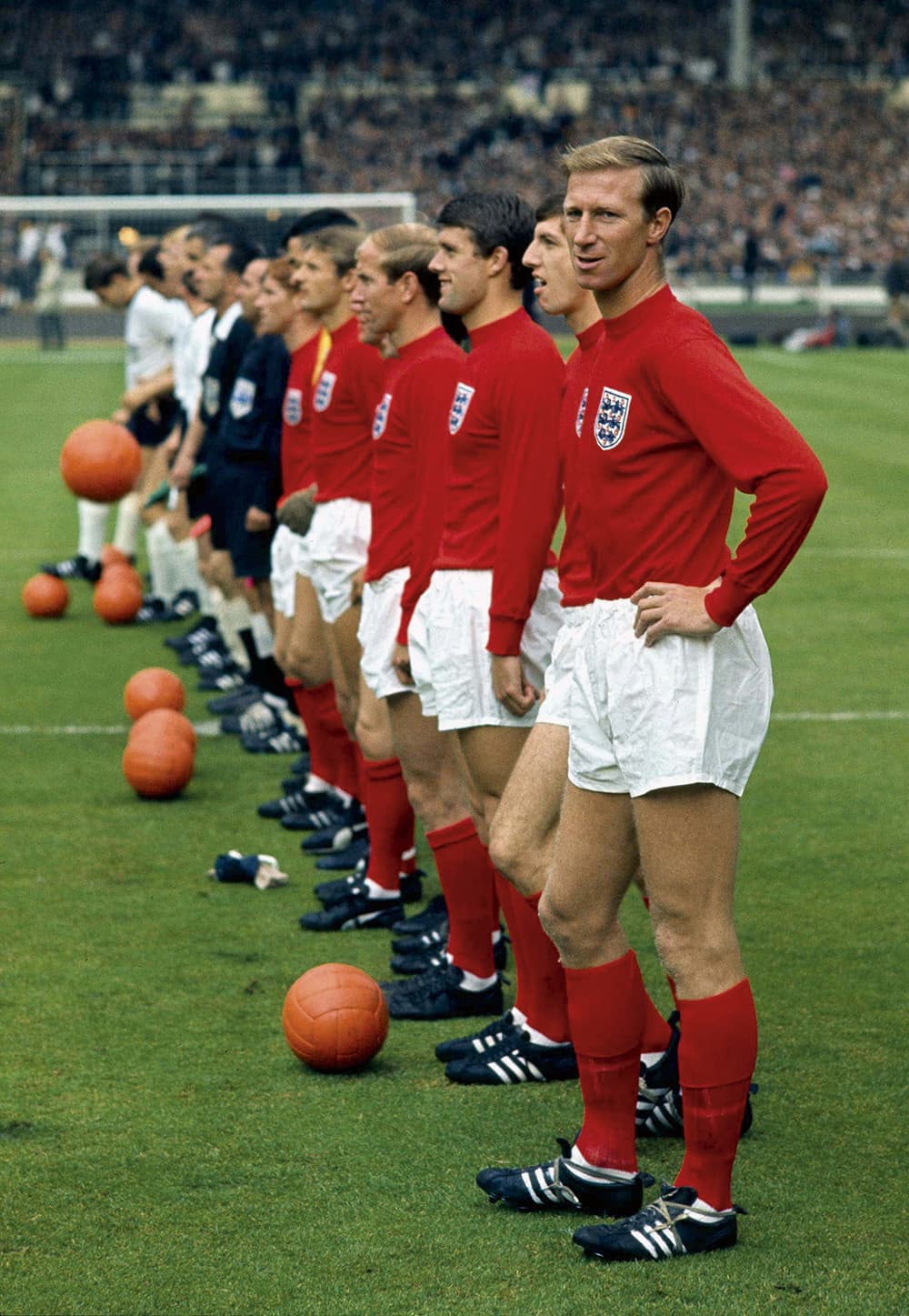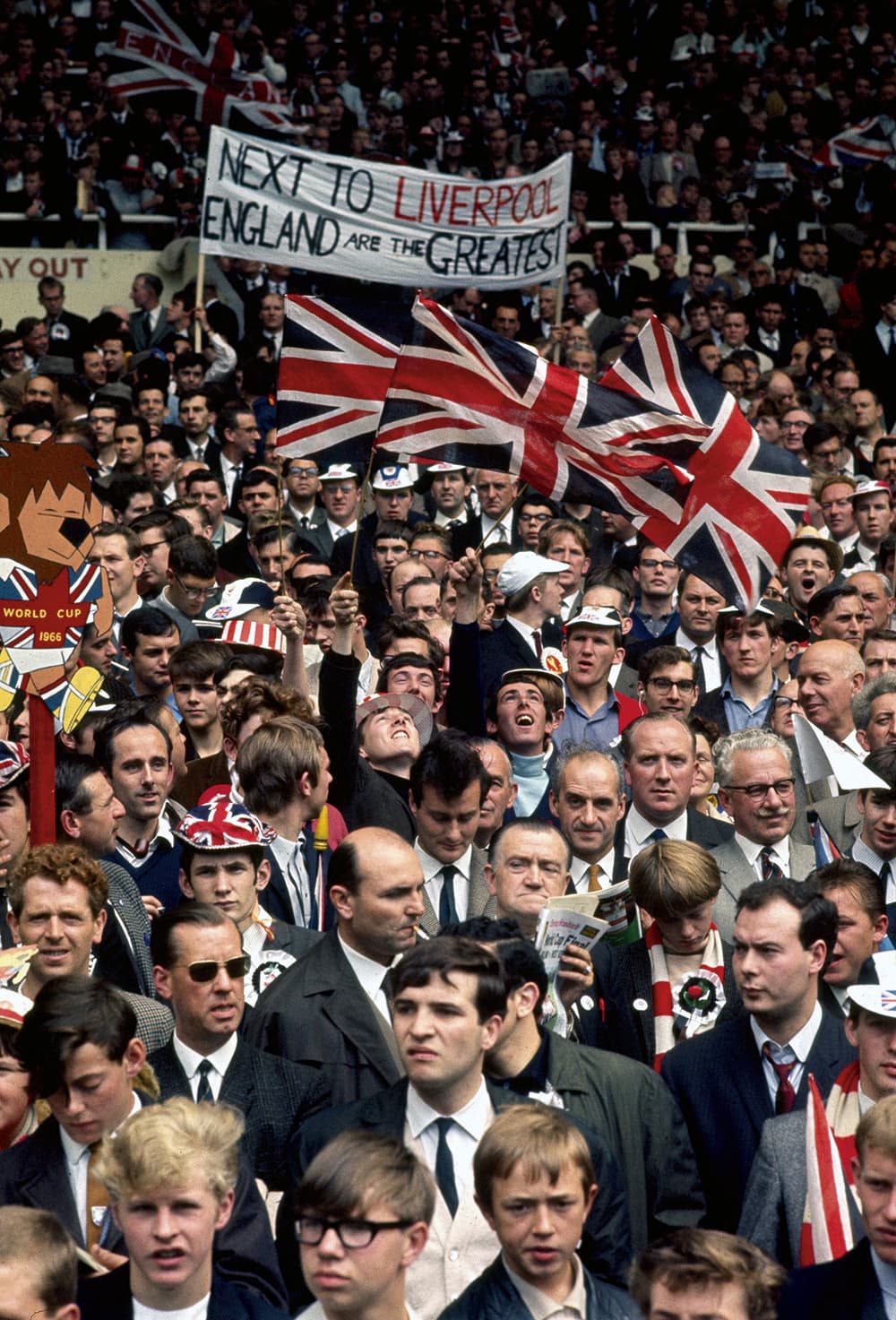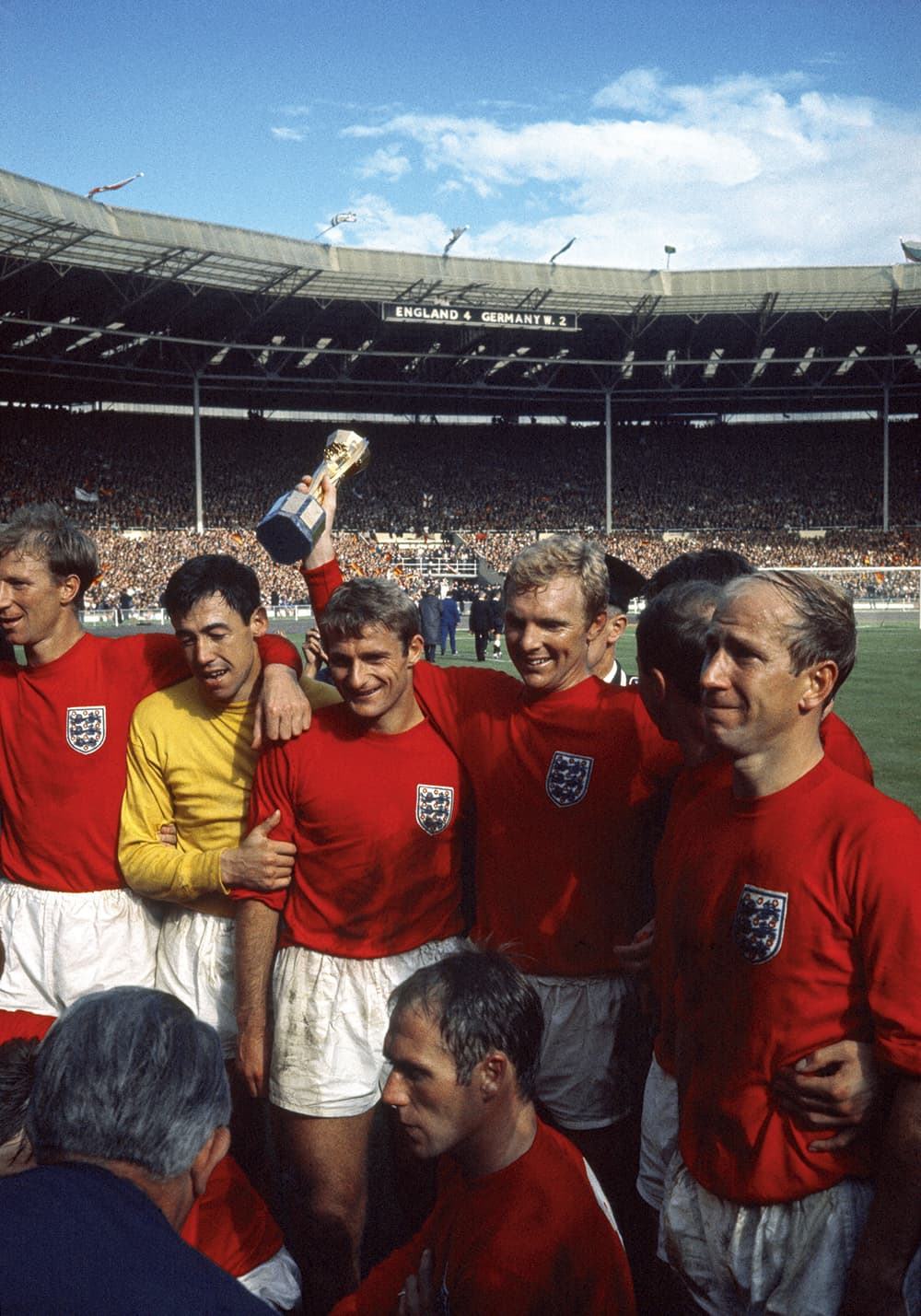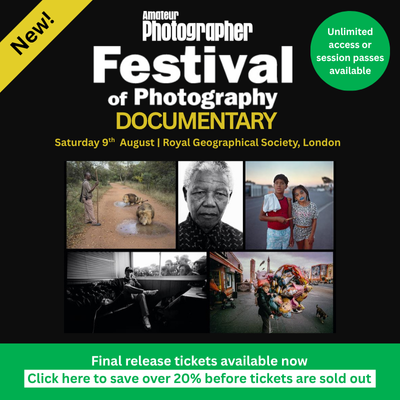
Jack Charlton and the England team line up for the national anthems. All pictures by Gerry Cranham
From the glistening gold of the Jules Rimet trophy, to the iconic long-sleeved red away shirts, England’s World Cup final triumph has become etched in our cultural consciousness. Whether you are a football fan or not, the scenes are instantly recognisable, and when we conjure up images of the match, we see them in our mind’s eye in glorious colour. This is partly down to photographer Gerry Cranham – one of only two photographers to capture that legendary game using colour film.
‘I met this chap who worked for Walt Disney’s London office,’ Gerry says. ‘He was a journalist and at the weekend he made up his money covering sports events for the Sunday papers. He said to me, “Gerry, colour is the future. You should be shooting colour.”’
It was this single piece of advice that spurred Gerry to start. ‘Of course, it was mainly black & white then – it was rare that anyone shot colour, particularly in sports photography.’
Gerry’s career as a sports photographer had started many years earlier, and almost by chance. After five years in the army with the Royal Electrical and Mechanical Engineers, Gerry’s promising athletics career was cut short by an injury.
‘I started coaching athletes and I thought it would be a good idea to get a camera to show someone how badly they were running,’ says Gerry. ‘I had to save over time to afford the camera – it was a Corfield Periflex, which was about £40, a lot of money then. I didn’t realise how expensive photography was.’

England fans before the 1996 final against West Germany
Armed with his camera and some basic knowledge, Gerry’s passion for photography began with some success, but it was a steep learning curve. ‘I had a guide – a little plastic card – with all the exposures, and it was trial and error,’ he says. ‘But I managed to sell the first roll of film that I took – I was never an amateur. There was this road relay from London to Brighton. A man from the local athletics club had a sports car, and I photographed the race all the way through. From that first roll of film I sold most of those pictures. They were very bad, I think.’
Managing to sell the images, Gerry was encouraged to keep persevering with his photography. ‘The stuff I used to sell from my first jobs was terrible, but there wasn’t the competition there is now. I went through hundreds of rolls of film. I had a great advantage in a way, having been an athlete for a number of years, so I was able to exploit that. It meant I knew when to take shots and when to keep out of the way.
‘I found out a little bit more about developing and printing. I bought a cheap enlarger and again it was all trial and error. I had to black out the kitchen in my little flat, as well as put my camera lens in my enlarger. Everything was really done on a shoestring.’
During the first three years of his career, Gerry exclusively photographed athletics. It was, as he admits, the only thing he really knew. However, things weren’t exactly straightforward.
‘Bit by bit, I managed to get in to an agency called Fox Photos,’ he explains. ‘The problem is, when I wanted to shoot, I couldn’t get proper access to the photographers’ areas at sporting events as you had to be a member of the National Union of Journalists. Much of the time I had to shoot from the crowd, and all sorts of places. But I got to know one or two people. I used to supply the local magazines and papers. I met a sports writer, John Rodda, who eventually became athletics correspondent for The Guardian. He introduced me to a lot of other journalists, and they helped me a great deal.

This shot of Jack Charlton attempting to tackle German striker Sigfried Held gives a good idea of where Gerry was positioned during the match
‘My pictures were quite different to the norm, but would get used in many national newspapers,’ Gerry continues. ‘On one occasion I had my photo in five national newspapers in one day. It was a picture of the London Polytechnic Marathon. I was late getting there, ran in and just photographed the runner running in to all the photographers. That was the picture that ended up appearing everywhere.’
Sports Illustrated picked up another picture of Gerry’s and as a result he got to know one of its great sports writers, John Lovesey, who was the London correspondent at the time. The pair became great friends over the years and Lovesey gave Gerry a great deal of instruction concerning what to do with his photography.
‘John Lovesey had worked with a lot of the best American photographers and he guided me,’ says Gerry. ‘Eventually, he became the managing editor for sport for the Sunday Times. John was a pioneer, as I was. A lot of the trends in sports photography now come from those early days. The chance to work for Sports Illustrated, the world’s best sports magazine, with its circulation of a million issues a week, and seeing the work and the standards [in the magazine], improved me beyond measure.’

Portugese superstar Eusébio sheds tears after being knocked out by England in the semi-final of the tournament
The World Cup final
In 1966, the best footballers on the planet were assembled in England, and it was a great opportunity for Gerry to photograph some of these superstars. Although it is the images of the final that are the most famous, Gerry was also at other World Cup games, notably England’s semi-final against Portugal. ‘One of those pictures won an award – it was of Eusébio,’ says Gerry. ‘I think I had the only colour picture of him.’
Shooting sports photography in colour was by no means easy, as there was limited choice of colour film. ‘I was using Ektachrome; it was only something like 60 ASA. By then I was reasonably proficient in colour, but it was difficult as the film speed was very slow.’
Gerry found himself at Wembley shooting for The Illustrated London News. The shot they wanted was the Queen presenting the trophy, but that wasn’t the only opportunity that presented itself on the day.
‘I could also work for Sports Illustrated. I don’t know why, but they didn’t have any proper passes. They had two photographers in the stand and even one in an aeroplane above. But I was the only one on the deck.’
At the last World Cup final in Brazil in 2014, there were hundreds of photographers, and Gerry recalls there were far fewer back in 1966. ‘I think there were 20 British photographers, and about seven Germans. As far as I know, only two photographers were shooting in colour.

Having won the World Cup, England manager Sir Alf Ramsey sits motionless and stunned
‘In the days of automated digital cameras, we have forgotten exactly what it was like for sports photographers shooting film. It was almost like exercise in itself, with a lot more thought and physical actions required to get the shots you wanted. I shot 28 rolls of film. It’s not like pushing buttons with autofocus. You had to get the exposure right, the film wasn’t very fast and you had to focus. I think I had four cameras on me. I had a long lens, a 200mm, a 30mm and then a 50mm. I was shooting 35mm film, and all the time I was concentrating on keeping the cameras loaded, not shooting too much, and picking my moments. I was using Nikon Fs with the motor drive then – they were only about two or three frames per second. The Nikon F was a very strong camera, and it didn’t go wrong very often.’
When it came to matters on the pitch, Gerry is full of praise for the team, and also for the manager, Sir Alf Ramsey. ‘That team was so skilfully picked and planned by Ramsey,’ says Gerry. ‘He’s one of the great managers of all time. Even when it was full time and it went to extra time, he made them all stand up and look well, as the Germans were all on the floor exhausted. That was the sort of thing he would think of. He wanted them to think the England team were still fresh in order to put them off. He was a great man, he had a great brain.’
With the front cover image for The Illustrated London News in the forefront of his mind, Gerry did miss a crucial moment of the match.
‘My main thing was that I had to go and get a picture up at the Royal Box. So I left my position in the bottom corner when England were leading and missed the last goal.’
However, this turned out to be rather serendipitous, as it led to one of the defining images of England’s win. As Gerry explains, ‘I went over in front of the dugout with the two teams and managers and I just sat there. Then suddenly there was this huge roar as the other goal went in. Seconds later it was the winning moment. Ramsey just sat there, and everyone else was just running around. He just sat there and didn’t do anything. He hardly smiled – it was just incredible. I was just amazed that the chap didn’t do anything. I just fired off two frames, as I had to get up top to get a spot on the balcony. But that image has been used lots and has now become a famous picture.’

The shot Gerry was required to get for Illustrated London News. HM the Queen presenting the Jules Rimet Trophy to England captain Bobby Moore
Legacy
He may not be the household name that many photojournalists are, but Gerry Cranham was a pioneer of sports photography, who helped to blur the boundaries between images that merely reported the events of a game and photographs that approached the subject almost as an art form. As a result the images entered the public consciousness.
‘I was so busy with advertising and sport, and this chap kept ringing me up and I’d say “give me a ring another time”. This went on for months,’ remembers Gerry. ‘Eventually I said, “Oh, you better come down and have lunch with me.” He turned out to be the deputy director of the V&A. Photography had taken off a bit then, and in 1968, the V&A had a Cartier-Bresson exhibition. My exhibition was the next one. I was the first British photographer to have a full exhibition there. I have to say, I’ve had a very busy career, and that’s why I’m so worn out now!’

The victorious champions celebrate
Gerry Cranham became a sports photographer in 1958 at the age of 27. One of the first sports photographers to use colour film, Gerry’s images have appeared in newspapers and magazines all over the world. Visit www.welloffside.com.









